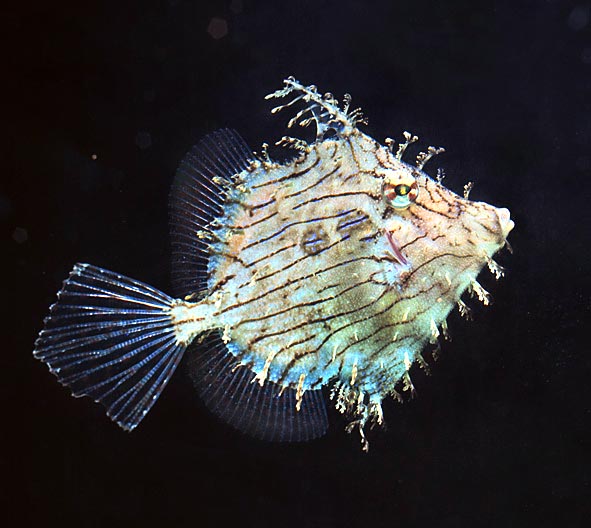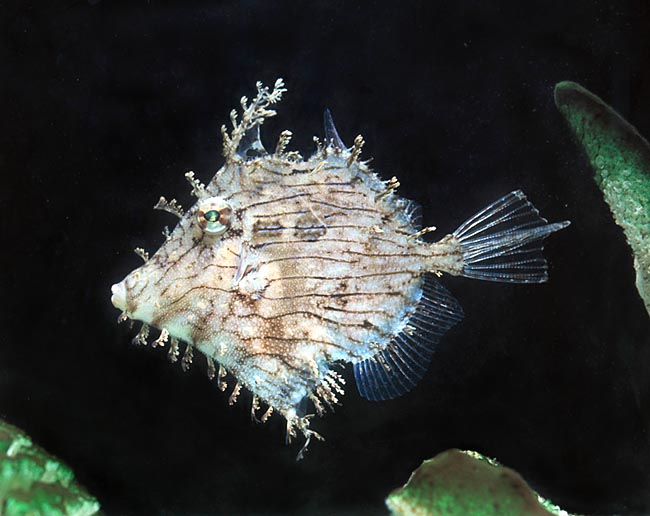Family : Monacanthidae

Text © Giuseppe Mazza

English translation by Mario Beltramini

Chaetodermis penicilligerus is a master of mimicry in the sandy corals © Giuseppe Mazza
The Prickly leatherjacket (Chaetodermis penicilligerus Cuvier, 1816) belongs to the class of the Actinopterygii, the ray-finned fishes, to the order of the Tetraodontiformes and to the fanciful family of Monacanthidae, the so-called “filefishes” due to the roughness of the skin, covered, like the Balistidae, by small bony plates, which here are minute and spaced with one or more spinules.
The name of the genus “chaetodermis” comes from the Greek “chaite” = hairs and from “derma” = skin, due to the showy protuberances of the skin. The name of the species “penicilligerus” comes from the Latin “penicillus” = brush, therefore, with reference to the showy panache of the head.
Zoogeography
It is present in the tropical waters of the eastern Indian Ocean and of the western Pacific Ocean. We find it, indicatively, in Cambodia, Thailand, Malaysia, Australia, Indonesia, New Guinea, Philippines and Taiwan and along the southern coasts of Japan.
Ecology-Habitat
It leaves among the corals and the weeds close to the sandy bottoms.
Morpho-physiology
It can exceed the 30 cm of length, but usually it has more modest measures, around the 25 cm. The body, of trapezoid shape, is flat and covered by more or less ramified excrescences which play an important camouflaging role along with the livery.
Like in the triggerfishes, the dorsal fins of the Monacanthidae are two, and the first, practically reduced to a long erectile spine, is placed in a more advanced position, mainly at the eye level. In the case of the Chaetodermis penicilligerus it is decorated by panaches and sided by a small spine. Then we have the second dorsal with 25-26 unarmed rays, almost identical to the anal which has 23-24 soft rays. The pectoral ones count 13-14 of them, the ventral ones have atrophied into an appendage and the caudal is clearly separated from the body by a thin peduncle.

Edible, excellent aquarium fish, it’s used by locals also as sandpaper © Giuseppe Mazza
Also this one, at times truncated in the big specimens, has a rhomboidal shape.
All fins are more or less transparent in order to confound the fish with the habitat and apart the excrescences also the livery is a masterpiece of mimetism. On the background, golden brown with small brown, green or bluish spots runs a dozen of thin black horizontal lines, irregular and mixed here and there with bright small points. This is ideal for camouflaging with the sand, the vegetation and the corals.
Ethology-Reproductive Biology
The Chaetodermis penicilligerus nourishes greedily of all the small animals it finds in the crevices of the corals, where it can easily enter thanks to its flat body and the pointed snout. Small crustaceans, annelids, molluscs, polyps, eggs and sea weeds: practically all what it can catch with its small mouth.
During the reproductive period the male surveys the eggs the female has stuck on the bottom in a sheltered location.
When swimming in small schools it often ends up in the trawls. The flesh is considered good by the locals and the skin once was used as sandpaper for smoothing the objects. It s also an excellent aquarium fish, much sought for due to its unusual look, easy to nourish, robust and friendly with the other fellow guests of the pool.
The populations can double in 1,4-4,4 years and the vulnerability index is presently modest, with a value of 34 on a scale of 100.
Synonyms
Balistes penicilligerus Cuvier, 1816; Chaetoderma penicilligera Cuvier, 1816; Chaetodermis maccullochi Waite, 1905; Chaetodermis penicilligera Cuvier, 1816.
→ For general information about FISH please click here.
→ For general information about BONY FISH please click here
→ For general information about CARTILAGINOUS FISH please click here.
→ To appreciate the BIODIVERSITY of BONY FISH please click here.
→ To appreciate the BIODIVERSITY of CARTILAGINOUS FISH please click here.
